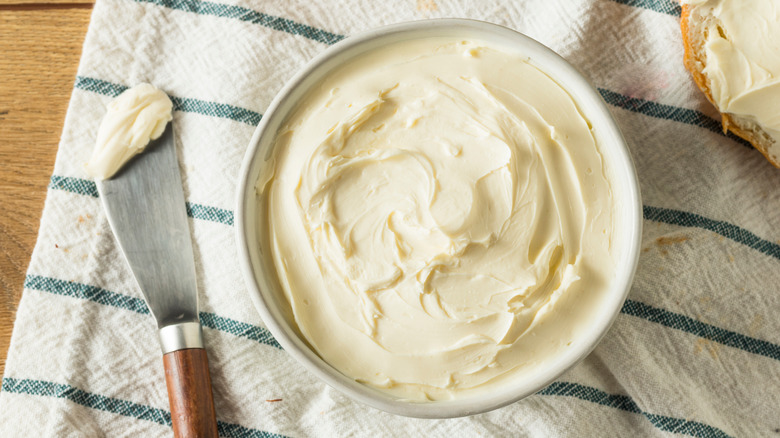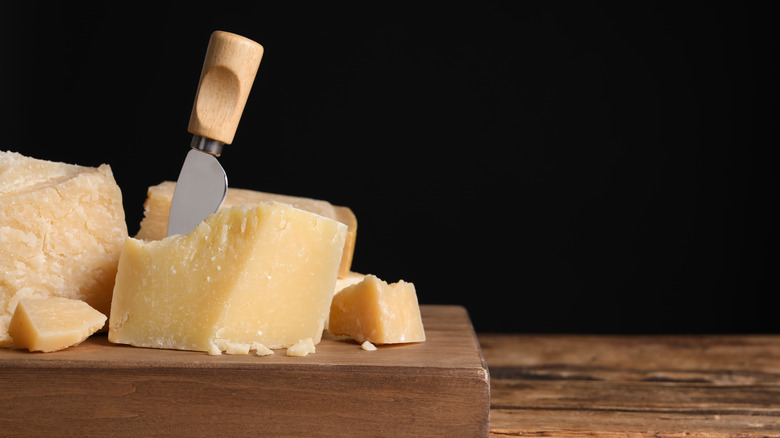Everything You Need To Know About Fromage Fort
If you like to cook, then you probably know that there's a whole genre of recipes dedicated to using up kitchen odds and ends, the various leftovers and scraps that end up in your refrigerator and pantry and are at risk of getting tossed out if they're not reinvented into something new. Think fried rice, a dish with a base of cold, dry rice and which often incorporates already cooked proteins such as pork or chicken. Or the Italian spaghetti frittata, which folds leftover pasta into a fluffy egg omelet. There's also crispy, golden brown croquettes, which are a handy way to use up extra mashed potatoes.
One classic member of the category of leftovers dishes is fromage fort, or "strong cheese," a recipe you may not have heard of that's an excellent — and tasty — way to use up the odds and ends of cheeses that are probably kicking around your refrigerator right this very minute.
What is fromage fort?
If you're a cheese lover and you haven't heard of fromage fort, today is your lucky day. A dip that's perfect for spreading across baguette, crackers, or raw vegetables, fromage fort makes use of any type of leftover cheese bits that are hanging out in the refrigerator, per Saveur. A piece of Havarti, a scrap of cheddar, a wedge of Brie — pretty much anything goes, and the cheeses get blitzed together in the food processor along with butter and dry white wine, coming together as a smooth, rich dip that's the perfect thing to throw together for a last-minute dinner party.
As its name indicates, fromage fort was traditionally a French dish, and it was made in a somewhat more labor-intensive way. According to the cheese magazine Culture, leftover cheese scraps were mashed together in a ceramic crock along with some liquid, covered, and left to ferment in a cool cellar until the mixture expanded and took on a strong, or "fort," flavor.
OG French chef Jacques Pépin told Culture that's exactly how his father used to make it, scraping together "bits of cheese that might otherwise have gone to waste." Pépin says his father would then "put it into a terrine with a bit of white wine, and let it marinate for two weeks until it fermented and softened. Then he would mash it up with garlic and add more white wine."
What does fromage fort taste like?
Fromage fort is a creamy, mild spread that most any cheese lover will enjoy. Today's dip is a far cry from the funky, fermented concoction from which the dish takes its name (via Culture); instead, it's an endlessly customizable spread that can be adapted to suit individual tastes.
Depending on which cheeses you want to toss into your fromage fort, it can taste more mild or more assertive. According to Bon Appétit, stronger cheeses such as blue cheese will lend funk, while more neutral cheeses such as muenster or gouda will create a milder spread. Harder cheeses such as Parmesan add saltiness to the dip, while a splash of dry white wine lends acidity. Most recipes call for some minced garlic, which brings a bit of heat and depth of flavor. Pair fromage fort with crackers, like sourdough, or consider raw carrots, apple slices, or rounds of cucumber, which can provide a nice freshness that can cut through the richness of this cheese spread.
How to make fromage fort
Cheese fans likely have all the ingredients on hand to make a fromage fort right now. Poke around your refrigerator to see which leftover cheeses you have, gathering strong cheeses like Stilton or Camembert, milder ones such as Brie, gouda, and cheddar, and aged ones such as Parmesan and pecorino. Trim any rind or mold from the cheeses, cube or crumble them, and make sure to grate the harder cheeses, per Bon Appétit.
Toss the cheeses into a food processor, add a dash of dry white wine and some softened butter, drop in some minced garlic, and pulse the dip together, scraping the sides of the food processor bowl a few times. When the mixture has come together, it will have about the same texture as whipped cream cheese. Taste it for seasoning, adding some salt or black pepper as needed.
At this point, your fromage fort is ready to be enjoyed alongside crackers, crusty baguette, and crudités. Food & Wine suggests spreading the cheese into a shallow dish and serving it cold, or running it under the broiler for a couple of minutes for a hot, bubbly version of fromage fort.
Packed into an airtight container, fromage fort will last up to one week, according to Saveur. It also freezes well, so go ahead and tuck some into the freezer for an even faster, easier option for your next unanticipated gathering.



